Introduction: The Emergence of a Landscape Artist
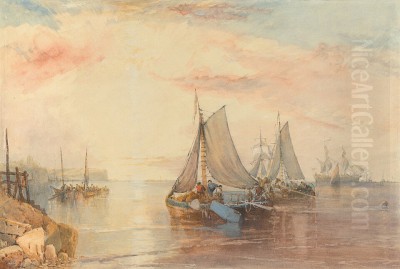
James Baker Pyne, born in Bristol, England, in 1800, stands as a significant figure in the rich tapestry of 19th-century British landscape painting. Spanning a career from the Regency period well into the Victorian era, Pyne carved a distinct niche for himself, moving from provincial recognition to national acclaim. Though initially destined for a different path, his innate passion for art led him to become a largely self-taught painter, eventually mastering the depiction of light, atmosphere, and the serene beauty of the natural world, as well as capturing moments of dramatic historical significance. His life and work offer a fascinating window into the artistic currents of his time, particularly the enduring appeal of Romanticism and the evolving techniques of landscape representation. He passed away in 1870, leaving behind a substantial body of work that continues to be admired for its technical skill and evocative power.
Early Life and Artistic Awakening in Bristol
Pyne's journey into the art world was not preordained. Born into a Bristol family, his initial training was geared towards the legal profession, undertaking an apprenticeship as a lawyer. However, the structured world of law could not contain his burgeoning artistic inclinations. From around the age of 18, Pyne began to dedicate himself seriously to the study of painting, driven by personal passion rather than formal instruction. This path of self-education required immense dedication and keen observation, qualities that would later define his meticulous approach to landscape.
Bristol, during Pyne's formative years, was a vibrant hub of artistic activity. It was the crucible for the emergence of the Bristol School of Artists, a loose collective known for their poetic and often atmospheric depictions of local scenery and imaginative subjects. Pyne naturally gravitated towards this environment. By 1824, his skills had developed sufficiently for him to exhibit his work publicly for the first time within his home city. This marked the beginning of his professional career and his integration into the local artistic community. He became an active participant in the various sketching clubs that flourished in Bristol, providing invaluable opportunities for artists to share techniques, critique each other's work, and undertake excursions to capture the surrounding landscapes.
The Influence of the Bristol School and Francis Danby
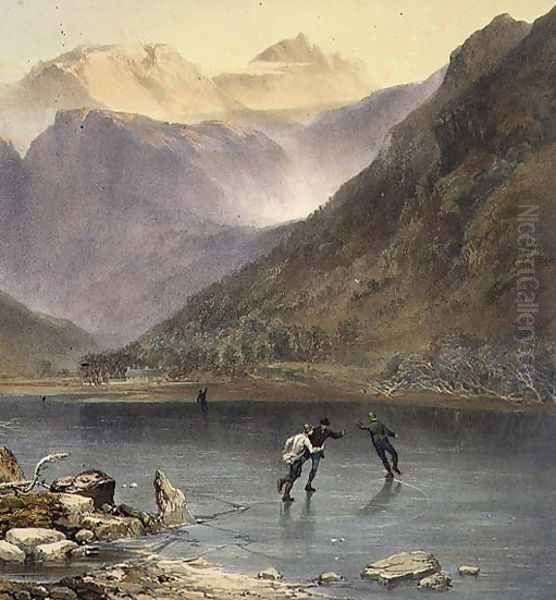
The artistic milieu of Bristol profoundly shaped Pyne's early development. He is considered part of the later phase of the Bristol School, absorbing the prevailing interest in atmospheric effects and romantic interpretations of nature. A key figure associated with the school, whose influence on Pyne is often noted, was Francis Danby (1793-1861). Danby, though Irish by birth, spent crucial years in Bristol and was renowned for his dramatic, often apocalyptic or mythological landscapes, imbued with powerful light and shadow.
While Pyne's temperament generally leaned towards more tranquil scenes than Danby's most dramatic works, the older artist's handling of light, his imaginative compositions, and his ability to evoke mood undoubtedly left an impression. Pyne learned to combine topographical accuracy with a heightened sense of atmosphere, creating landscapes that felt both real and emotionally resonant. Other artists associated with the Bristol scene, such as Edward Villiers Rippingille (1798-1859) and Samuel Jackson (1794-1869), also contributed to the dynamic environment in which Pyne honed his craft. Jackson, in particular, became a friend and occasional collaborator.
Pyne's early works often depicted the picturesque scenery around Bristol, including the Avon Gorge and the Severn Estuary. He developed a facility for capturing the specific qualities of light at different times of day and under various weather conditions. His technique involved careful drawing and the application of delicate layers of paint or watercolour washes to build up form and atmosphere, demonstrating a meticulousness born perhaps from his self-directed learning process.
Documenting History: The Bristol Riots of 1831
A significant, albeit grim, episode in Bristol's history provided Pyne with an unusual subject: the Bristol Riots of October 1831. These riots erupted following the House of Lords' rejection of the Second Reform Bill, leading to widespread disorder, looting, and arson over three days. Several public buildings and private homes were destroyed, and the military intervention resulted in numerous casualties.
Pyne, present in the city during these tumultuous events, turned his artistic skills to documenting the scenes of destruction. He created several works depicting the aftermath, including views of the burning New Gaol and the ruins of the Toll House on Prince Street Bridge. These paintings and drawings serve not only as artistic responses but also as valuable historical records of a pivotal moment in Bristol's social and political history. They showcase Pyne's ability to adapt his landscape skills to represent contemporary events, capturing the dramatic and chaotic atmosphere with a reporter's eye for detail, albeit rendered with artistic sensibility. His depiction of these events highlights a different facet of his work, moving beyond idyllic nature to engage with the harsh realities of urban unrest.
Mentorship and Artistic Relationships: William James Müller
![[lake Scenery Of England] by James Baker Pyne](https://www.niceartgallery.com/imgs/2694991/m/james-baker-pyne-lake-scenery-of-england-68f4ebe1.jpg)
Beyond his own artistic output, Pyne played a role in nurturing the next generation of Bristol talent. His most notable student was William James Müller (1812-1845), another Bristol-born artist who would achieve considerable fame, particularly for his landscape and ethnographic paintings based on his travels in the Near East. Müller received instruction from Pyne in his youth, and Pyne's influence is discernible in Müller's early handling of landscape, particularly his attention to natural detail and atmospheric effects.
Müller, like Pyne, also documented the 1831 Riots, creating his own powerful sketches and paintings of the event. The shared experience of witnessing and recording this local trauma likely forged a bond between the two artists, despite their different career trajectories later on. Müller's tragically short but brilliant career saw him develop a bolder, more fluid style than Pyne's, yet the foundational skills imparted by his teacher were crucial. This mentorship role underscores Pyne's standing within the Bristol art community before his departure for London. His interactions extended to others in the Bristol circle, including Samuel Colman (active c. 1816-1840) and potentially members of the talented Sharples family, such as Rolinda Sharples (1793-1838), known for her detailed genre scenes.
The Move to London and National Recognition
By 1835, Pyne recognized that London offered greater opportunities for exhibition and patronage than Bristol. He relocated to the capital, seeking to establish his reputation on a national stage. This move proved successful. He began exhibiting regularly at the prestigious Royal Academy of Arts, the premier venue for artists seeking critical recognition and sales. His meticulously finished landscapes found favour with the London audience.
Alongside the Royal Academy, Pyne became a frequent exhibitor at the Society of British Artists (SBA), located in Suffolk Street. This society provided an alternative exhibition space for artists, often showcasing works that might differ in style or scale from those favoured by the Academy. Pyne's commitment to the SBA was significant; he was elected a member and eventually served as its Vice-President. This position indicates the respect he commanded among his peers in the London art world, exhibiting alongside established figures like Clarkson Stanfield (1793-1867) and David Roberts (1796-1864), both renowned for their topographical and landscape work. His London base allowed him to engage more directly with the broader currents of British art, including the towering influence of J.M.W. Turner.
Artistic Style: Romanticism, Detail, and Atmosphere
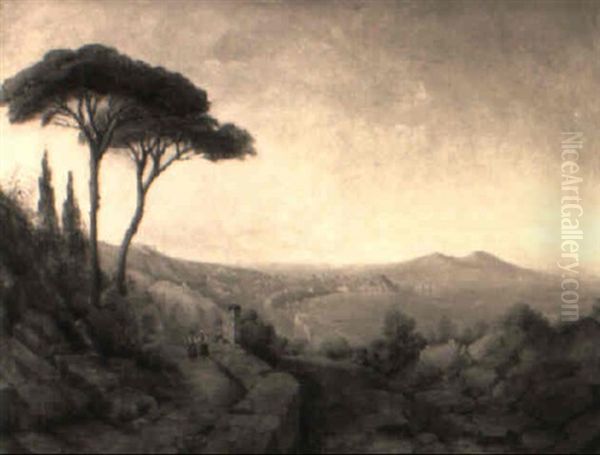
James Baker Pyne's style is firmly rooted in the English Romantic landscape tradition, yet it possesses distinct characteristics. While often compared to Joseph Mallord William Turner (1775-1851), particularly in his handling of light and atmospheric effects, Pyne generally maintained a greater degree of topographical clarity and detailed finish than seen in Turner's more radical later works. His paintings often evoke a sense of tranquility and idyllic beauty, celebrating the pastoral charm of the British countryside.
His technique was characterized by careful draughtsmanship underpinning compositions bathed in soft, diffused light. He excelled at rendering the textures of foliage, the reflections in water, and the subtle gradations of colour in the sky. Whether working in oils or watercolours, Pyne applied paint with precision, often using fine brushes to delineate details in the foreground while employing broader washes or glazes to create atmospheric perspective in the distance. This combination of detail and atmosphere gives his work a luminous, almost jewel-like quality.
While influenced by Turner's exploration of light and colour, Pyne's vision remained perhaps closer in spirit to the calmer aspects of Romanticism found in the works of artists like John Constable (1776-1837) in his more finished pieces, or the detailed rendering seen in some Pre-Raphaelite landscapes later in the century, though Pyne's work predates their main movement. He captured the poetic essence of a scene, emphasizing harmony between humanity and nature, often including small figures or dwellings to provide scale and a sense of gentle habitation within the landscape. His preference was often for serene, sunlit views, though he could also effectively capture the more dramatic moods of nature, such as gathering storms or misty mornings.
Travels Abroad: Broadening Horizons
Like many British artists of his generation, Pyne sought inspiration beyond the shores of Britain. Between 1846 and 1847, he undertook a significant tour of the continent, visiting Italy, Switzerland, and Germany. This journey exposed him to different landscapes, architectural styles, and qualities of light, enriching his artistic vocabulary. Italy, in particular, with its classical ruins, picturesque towns, and dramatic coastal scenery, had long been a magnet for British artists following the tradition of the Grand Tour.
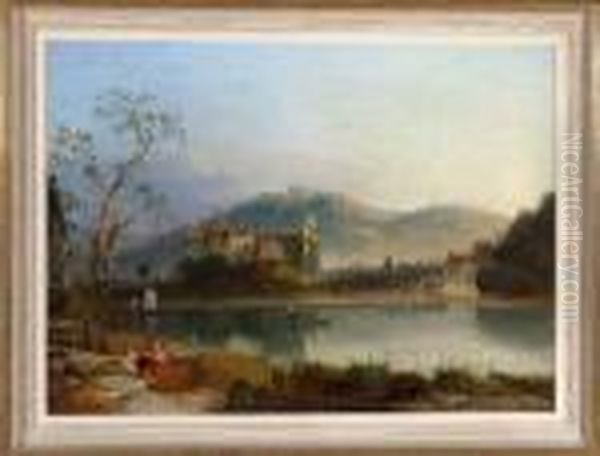
The sketches and studies made during these travels provided source material for numerous paintings completed upon his return to England. His depictions of Italian lakes, Swiss mountains, and Rhineland castles added variety to his oeuvre. These works often display a brighter palette and a focus on the interplay between dramatic natural settings and historical architecture, reflecting the influence of the continental picturesque tradition. This experience broadened his subject matter and likely reinforced his appreciation for the atmospheric effects he had already mastered in depicting British scenery. His travels placed him in the lineage of travelling landscape artists like Richard Parkes Bonington (1802-1828) and Samuel Prout (1783-1852), who brought continental views to British audiences.
Masterworks and Notable Series: Capturing the English Lakes
Pyne is perhaps best known today for his depictions of the English Lake District. This area, celebrated by the Lake Poets like William Wordsworth and Samuel Taylor Coleridge, became a prime destination for artists seeking sublime and picturesque scenery. Pyne made several visits to the region, capturing its unique combination of mountains, lakes, and pastoral valleys with great sensitivity.
His dedication to this region culminated in the publication of several series of prints based on his watercolours. One of the most significant was The English Lake District, published in 1853. This volume featured high-quality chromolithograph plates reproducing Pyne's watercolours, accompanied by descriptive text. It showcased his ability to capture the specific character of locations like Windermere, Derwentwater, and Ullswater.
Another important work, often cited as representative, is Brother's Water, depicting a smaller lake near Ullswater. Paintings and prints of this subject exemplify Pyne's skill in rendering tranquil water surfaces, reflections, and the surrounding fells under soft, atmospheric light. His series Lake Scenery of England, published later (though possibly based on earlier work), further cemented his reputation as a leading interpreter of this iconic landscape. These publications, utilizing advances in printmaking, made his interpretations accessible to a wider audience beyond those who could afford original paintings. His focus on specific, named locations aligns him with the topographical tradition, yet his execution elevates the scenes through Romantic sensibility. Cook's Folly, depicting a landmark tower in the Avon Gorge near Bristol, represents his earlier engagement with local picturesque sites.
Pioneering Printmaking Techniques: Chromolithography
Pyne's involvement with publications like The English Lake District highlights his engagement with the developing field of printmaking, particularly chromolithography. This technique, which allowed for the printing of images in multiple colours, was gaining sophistication during the mid-19th century. It offered a way to reproduce the subtle tones and colours of watercolour paintings more faithfully than earlier hand-colouring methods applied to engravings or lithographs.
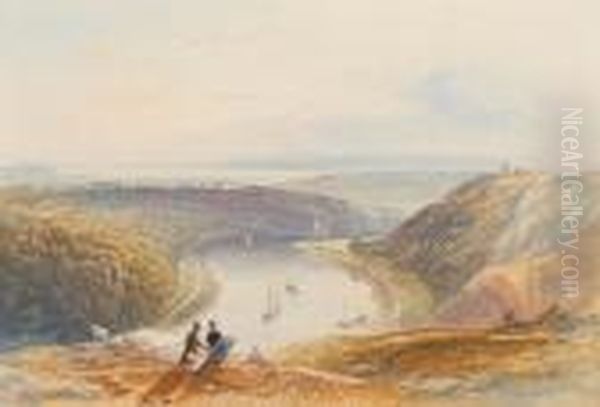
Pyne's Lake Scenery of England is sometimes cited as an early and successful example of chromolithography, potentially utilizing three-colour printing processes. By embracing this technology, Pyne was not only disseminating his work but also participating in the technological advancements that were transforming visual culture. Artists like Owen Jones (1809-1874), known for his work on colour theory and decorative patterns, were also exploring the potential of chromolithography during this period. Pyne's use of the medium demonstrated its suitability for capturing the delicate nuances of landscape art, contributing to its acceptance as a legitimate form of artistic reproduction. This engagement shows Pyne as an artist attuned to the technical possibilities of his era, seeking ways to share his vision broadly.
Later Career and Legacy
James Baker Pyne continued to paint and exhibit throughout the 1850s and 1860s, maintaining his characteristic style while perhaps incorporating some influences from the changing tastes of the mid-Victorian era. He remained a respected figure in the London art world, though perhaps overshadowed in public acclaim by the rise of the Pre-Raphaelites and other new movements. His dedication to landscape painting, however, remained constant.
His legacy rests on his contribution to the English Romantic landscape tradition. He successfully synthesized the atmospheric concerns of Turner with a detailed finish that appealed to Victorian sensibilities. His works are admired for their technical proficiency, particularly in watercolour, and their ability to evoke a sense of peace and harmony in nature. He captured the specific beauty of various British regions, most notably the Lake District and the environs of his native Bristol, leaving behind a valuable record of these landscapes as they appeared in the 19th century.
His influence extended through his teaching, particularly on William James Müller, and through the dissemination of his work via prints. He stands alongside other dedicated landscape specialists of his time, such as David Cox (1783-1859) and Peter De Wint (1784-1849), as an artist who celebrated the particular character of the British countryside. Though perhaps not as revolutionary as Turner or Constable, Pyne produced a consistently high quality of work that earned him a secure place in the history of British art. His paintings are held in numerous public collections in the UK and internationally, attesting to his enduring appeal.
Conclusion: An Enduring Vision of Landscape
James Baker Pyne's career exemplifies the journey of a dedicated artist who, through self-discipline and a keen sensitivity to his environment, rose from provincial beginnings to achieve national recognition. As a key figure emerging from the Bristol School, he carried forward a tradition of atmospheric and poetic landscape painting. His meticulous technique, combined with a Romantic sensibility influenced by masters like Turner and Danby, allowed him to create enduring images of British and continental scenery. From his early documentation of the Bristol Riots to his celebrated views of the Lake District, Pyne's work offers both historical insight and aesthetic pleasure. His role as a mentor to Müller and his engagement with printmaking further highlight his contributions to the artistic life of his time. James Baker Pyne remains an important painter for anyone interested in the evolution of British landscape art during the 19th century, admired for his skillful rendering of light, detail, and the tranquil beauty of the natural world.